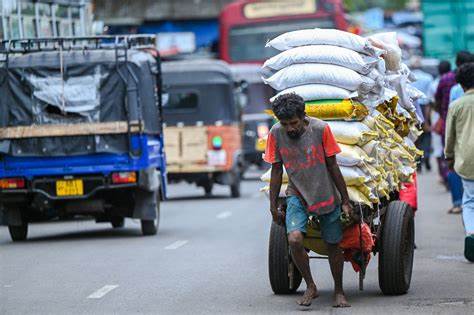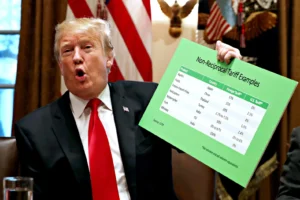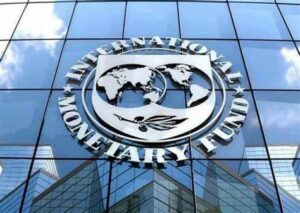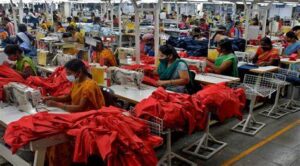
Sri Lanka’s Economy Anchored by IMF Progress, Trade Diplomacy, and Emerging Tariff Pressure
- CNL Reporter
- April 26, 2025
- Weekly Economic Review
- Sri Lanka’s Economy
- 0 Comments
WEEKLY ECONOMIC REVIEW
Sri Lanka’s economic landscape for the week ending April 26, 2025, presents a mixture of positive momentum and emerging challenges, as the country continues its post-crisis recovery while navigating complex international trade dynamics.
The current coutry’s economy is showing signs of recovery, bolstered by a staff-level agreement with the International Monetary Fund (IMF) for the fourth review under the Extended Fund Facility. This agreement paves the way for the disbursement of approximately US$344 million, bringing total IMF support to about US$1.72 billion.
However, the nation faces significant external challenges, notably the imposition of U.S. tariffs on Sri Lankan exports, particularly in the apparel sector. These tariffs, initially set at 44%, have been temporarily reduced to a baseline of 10%, but they continue to pose risks to export revenues and employment in a key industry that employs nearly 15% of the workforce.

Despite these headwinds, the World Bank projects a 3.5% growth in Sri Lanka’s economy for 2025, following a 5% rebound in 2024. The government’s commitment to structural reforms, including fiscal consolidation and debt restructuring, has been instrumental in this recovery.
Efforts are also underway to strengthen trade relations, with Sri Lanka and the United States engaging in discussions to finalize a bilateral trade agreement. Such an agreement could provide more stable and favorable conditions for Sri Lankan exports, mitigating some of the adverse effects of current trade tensions.
While Sri Lanka’s economic indicators are improving, sustained recovery will depend on navigating global trade uncertainties and maintaining the momentum of domestic reforms.
The International Monetary Fund (IMF) program in Sri Lanka recorded a major milestone this week, with a staff-level agreement reached for the fourth review under the Extended Fund Facility (EFF) arrangement.

This agreement clears the path for the disbursement of an additional SDR 254 million (approximately US$344 million), bringing the total IMF support to SDR 1,270 million (US$1,722 million). Encouragingly, the IMF noted strong overall program performance, with most quantitative targets met and a notable 5% GDP growth rebound in 2024 after the 2022-2023 economic crisis.
On the diplomatic front, Sri Lanka achieved a breakthrough by accelerating talks toward a bilateral trade agreement with the United States, following a high-level meeting between a Sri Lankan delegation and U.S. Trade Representative Ambassador Jamieson Greer on April 22 in Washington, D.C.
This proposed agreement is a critical step toward deeper global integration, at a time when Sri Lanka urgently seeks to diversify export markets and secure long-term access to major economies.
However, clouds loom over the export sector, particularly for Sri Lanka’s apparel industry, as the country grapples with the impact of new U.S. tariff increases.
Apparel exporters are feeling the pinch of the 44% Trump-era tariffs, which have not been eased under the current administration.

The Joint Apparel Association Forum has called for parity with other manufacturing nations, highlighting the risks to an industry that employs nearly 15% of Sri Lanka’s workforce and remains a crucial pillar of the national economy.
Key risks from the U.S. tariff actions include:
10% decline in overall U.S. apparel consumption, driven by rising costs.
Potential 15% reduction in U.S. apparel imports over the medium term, affecting Sri Lankan order books.
1-5% margin pressure on Sri Lankan suppliers who cannot pass on full cost increases.
Small and mid-sized exporters at high risk of margin erosion and business failure.
Threats to employment in the garment sector, which could stall economic recovery.
The Colombo Stock Exchange (CSE) has already begun reacting negatively, with stocks linked to export sectors—particularly companies like MGT, TJL, and HELA—experiencing significant volatility.
Despite these headwinds, Sri Lanka has gained a three-month window to negotiate with U.S. authorities on tariff reductions, a crucial breathing space. In parallel, the government is doubling down on efforts to maintain GSP+ access to the European Union (EU)—an incentive that grants Sri Lanka duty-free access to over 6,000 product lines including textiles, garments, and seafood.
However, continuation of this facility beyond 2025 hinges on Sri Lanka’s compliance with international human rights, labour, environmental, and governance standards. The EU has warned that economic hardship will not lower compliance requirements.
Meanwhile, on the macroeconomic front, there are several bright spots:
Lower global oil prices are expected to yield US$250–400 million in savings on Sri Lanka’s oil import bill, helping to stabilize the balance of payments and support the exchange rate.

Interest rates are trending downward, supported by easing inflation and faster global monetary easing, creating a more favorable investment environment domestically.
While the immediate economic narrative is one of cautious optimism due to IMF progress and proactive trade diplomacy, the next six months will be critical. Sri Lanka must successfully conclude trade negotiations with the U.S. and demonstrate tangible human rights progress to safeguard access to the EU market.
Failure on either front could derail the fragile recovery and risk renewed external vulnerabilities. Proactive reforms, sustained diplomatic engagement, and domestic resilience-building will be essential to sustain the momentum achieved so far.

